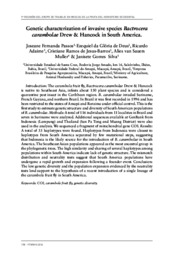Genetic characterization of invasive species Bactrocera carambolae Drew & Hancock in South America.
Genetic characterization of invasive species Bactrocera carambolae Drew & Hancock in South America.
Author(s): PASSOS, J. F.; DEUS, E. da G. de; ADAIME, R.; JESUS-BARROS, C. R. de; MULLER, A. van S.; SILVA, J. G.
Summary: The carambola fruit fly, Bactrocera carambolae Drew & Hancock is native to Southeast Asia, infests about 150 plant species and is considered a quarantine pest insect in the Caribbean region. B. carambolae invaded Suriname, French Guyana, and northern Brazil. In Brazil it was first recorded in 1996 and has been restricted to the states of Amapá and Roraima under official control. This is the first study to estimate genetic structure and diversity of South American populations of B. carambolae. Methods: A total of 116 individuals from 11 localities in Brazil and seven in Suriname were analyzed. Additional sequences available at GenBank from Indonesia (Lampung) and Thailand (San Pa Tong and Muang District) were also used in the analysis. We sequenced a fragment of mitochondrial gene COI. Results: A total of 35 haplotypes were found. Haplotypes from Indonesia were closest to haplotypes from South America separated by few mutational steps, suggesting that Indonesia is the likely source for the introduction of B. carambolae in South America. The Southeast Asian populations appeared as the most ancestral group in the phylogenetic trees. The high similarity and sharing of several haplotypes among populations within South America indicate lack of genetic structure. The mismatch distribution and neutrality tests suggest that South America populations have undergone a rapid growth and expansion following a founder event. Conclusion: The low genetic diversity and the population expansion evidenced by the neutrality tests lend support to the hypothesis of a recent introduction of a single lineage of the carambola fruit fly in South America.
Publication year: 2016
Types of publication: Abstract in annals or event proceedings
Unit: Embrapa Amapá
Observation
Some of Embrapa's publications are published as ePub files. To read them, use or download one of the following free software options to your computer or mobile device. Android: Google Play Books; IOS: iBooks; Windows and Linux: Calibre.
Access other publications
Access the Agricultural Research Database (BDPA) to consult Embrapa's full library collection and records.
Visit Embrapa Bookstore to purchase books and other publications sold by Embrapa.

